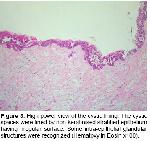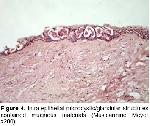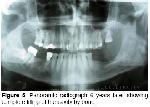The GOC is a rare cyst of all the jaw cysts hereby presented and its prevalance is <1%
7.
Clinically, the most common site of occurrence is mandibular anterior region3,10,12, but in the current case report, extension from the left mandibular premolar to molar region was reported. It has been shown in the literature that there is a male predilection and lesion occurs mostly in middle aged patients3,5,7. In the present case, patient was a middle aged man. This corroborates the reports in the literature. Radiographically, GOC is usually localized intraosseous and may appear as a unilocular or multilocular radiolucent lesion with well defined borders4,10. Sometimes presenting as peripheral osteosclerosis and scalloping, root resorption and displacement of tooth are also noted. The most common symptom is asymptomatic slow growing swelling4,5. Most authors agree that the clinical and radiographic features are not pathognomic of GOC4,5,9. The differential diagnosis is made with keratocysts, central mucoepidermoid carcinoma and ameloblastoma9,10.
In the present case, lesion detected incidentally in routine panoramic radiological examination appeared as a well defined unlilocular radiolucency in the region extending from the distal of left lower canine teeth to the ramus of the mandibula and root resorption was seen in lower mandibular first and second molar.
The CT scans are recommended because they provide accurate information about locularity of the lesion, cortical integrity, expansion of the lesion and involvement of the contiguous sft tissue. The CT scan revealed a multilocular lesion and cortical bone perforation, validating the need for the multiple plan images in cases of GOC. The CT clarified the limits of the lesion, cortical bone perforation, the involvement of the adjacent tissues and proved helpful in treatment planning3. In this case, CT examination suggests that vestibular bone is at normal density, destruction is present in lingual bone and that lesion develops expansively rather than by making infiltration.
An incisional biopsy, fine needle aspiration and exfoliative cytologic examination can help to differantiate between GOC and other similar lesions. But their true nature can only be determined by histopathologic examination5. In the present study, the initial diagnostic hypothesis was of dentigerous cyst, so that we decided to perform the complete surgical removel of the lesion with curretage. The specimen sent to the oral pathology laboratory to certain histopathological analysis.
Histopathologically GOC should be differentiated from lateral periodontal cyst (LPC), botryoid odontogenic cyst (BOC) and central mucoepidermoid carcinoma. LPC is a developmental odontogenic cyst lined by thin non-keratinized epithelium and also exhibits focal epithelial thickenings and glycogen rich epithelial cells. BOC is a locally aggressive polycystic variant of LPC and it consists of epithelial plaques and areas of glycogen rich clear cells14. However, the identification of ciliated epithelium and duct like spaces with mucous cells specifically differentiated from LPC and BOC. The differentiation of low grade central mucoepidermoid carcinoma (LGCMEC) from GOC especially its multicystic variant is more important and difficult. Significant histological overlap exists between GOC and LGCMEC. However, superficial cuboidal cells, epithelial whorls, ciliated cells, and intraepithelial microcyst or duct like structures are not typical for LGCMEC and their presence or absence can help in establishing a definitive diagnosis15. In our case histopathologically consisted of certain characteristic features of GOC like non-keratinized stratified epithelium, epithelial whorls or spheres within the lining, eosinophilic cuboidal or columnar cells which are occasionally ciliated and presence of mucous cells with microcystic areas. These findings helped us to confirmed the final diagnosis of GOC.
Various treatments ranging from curretage, enucleation to marginal resection and segmental resection are present in GOC3,5. Minor procedures such as enucleation or curretage are the most frequent types of treatment are reported in literature6. The recurrence mechanism may be partially related to the thinness of the cyst wall and the presence of microcysts that hamper the complete removal of the lesion, as well as the surgical technique employed for treatment16. The aggressive nature of GOC is also cited as a possible cause of recurrence17. As a result, a local block excision is suggested as the best treatment option16. In the present study, based on the patient's decision, the surgeon prefered conservative treatment with careful curettage to avoid damage to the inferior alveolar nerve. During surgery the lesion was easily removed and there were not any distruption of the cyst wall. Long term follow up was performed by periodical radiographic examinations for six years.
The aggressive nature of the lesion was evident, especially because of the recurrence and the significant increase in size since the first diagnosis3. Thus GOC cases need a long follow-up period for the recurrence rate to be evaluated6. In the present case, follow up was made for six years due to the high recurrence rate of GOC and no recurrence was observed.
In conclusion GOC is a rare and aggressive lesion with a high recurrence rate. Careful clinical and radiological evaluation must be carried out. The increased recurrence rates can be due to multilocularity of the cyst and incomplete removal of the lining following conservative treatment. Long term followed-up of patients with diagnosis of GOC is required.
Conflicts of interest: The authors declare that they have no conflict of interest. We have not contacted any company with regard to this article.







